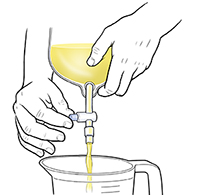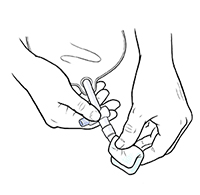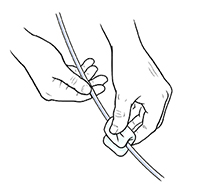Discharge Instructions: Caring for Your Indwelling Urinary Catheter
You have been discharged with an indwelling urinary catheter. It's also called a Foley catheter. A catheter is a thin, flexible tube. An indwelling urinary catheter has 2 parts. The first part is a tube that drains urine from your bladder. The second part is a bag or other device that collects the urine.
The most important thing to remember is that you want to prevent infection. Always wash your hands before handling your catheter bag or tubing.
Draining the bedside bag
-
Wash your hands with soap and clean, running water. Or use an alcohol-based hand sanitizer that contains at least 60% alcohol.
-
Hold the drainage tube over a toilet or measuring container.
-
Unclamp the tube and let the bag drain.
-
Don’t touch the tip of the drainage tube or let it touch the toilet or container.
-
You don't need to rinse the bag or drainage tube.

Cleaning the drainage tube
-
When the bag is empty, clean the tip of the drainage tube with an alcohol wipe.
-
Clamp the tube.
-
Reinsert the tube into the pocket on the drainage bag.

Cleaning your skin and tubing
-
Clean the skin near the catheter with soap and water.
-
Wash your genital area from front to back.
-
Wash the catheter tubing. Always wash the catheter in the direction away from your body.
-
You will be told when and how to change your bag and tubing.
-
Don’t try to remove the catheter by yourself.
-
You may shower with the catheter in place.

Emptying a leg bag
-
Wash your hands.
-
Remove the stopper on the bag.
-
Drain the bag into the toilet or a measuring container. Don’t let the tip of the drainage tube touch anything, including your fingers.
-
Clean the tip of the drainage tube with alcohol.
-
Replace the stopper.
Follow-up care
Make a follow-up appointment, or as directed by your healthcare provider.
When to call your healthcare provider
Call your healthcare provider right away if you have any of the following:
-
Fever of 100.4°F ( 38°C) or higher, or as directed by your provider
-
Chills
-
Leakage around the catheter insertion site
-
Increased spasms (uncontrollable twitching) in your legs, belly (abdomen), or bladder. Occasional mild spasms are normal.
-
Burning in the urinary tract, penis, or genital area
-
Nausea and vomiting
-
Aching in the lower back
-
Cloudy or bloody (pink or red) urine, sediment or mucus in the urine, or bad-smelling urine
Online Medical Reviewer:
Marc Greenstein MD
Online Medical Reviewer:
Raymond Kent Turley BSN MSN RN
Online Medical Reviewer:
Rita Sather RN
Date Last Reviewed:
9/1/2022
© 2000-2025 The StayWell Company, LLC. All rights reserved. This information is not intended as a substitute for professional medical care. Always follow your healthcare professional's instructions.